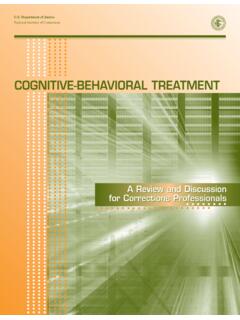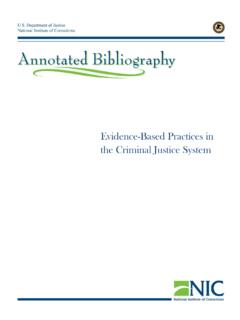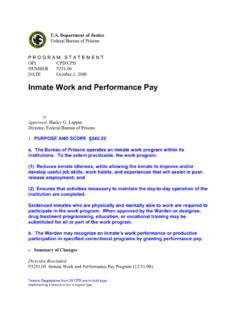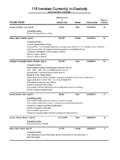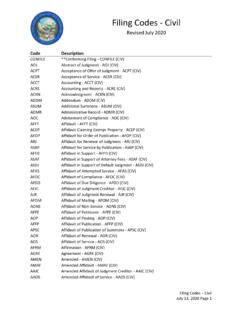Transcription of Prisoner Intake Systems: Assessing Needs and Classifying ...
1 Department of JusticeNational Institute of CorrectionsAssessing Needs and Classifying Department of JusticeNational Institute of Corrections320 First Street , DC 20534 Morris L. Thigpen, DirectorLarry Solomon, Deputy DirectorSusan M. Hunter, Chief, Prisons DivisionMadeline Ortiz, Project ManagerNational Institute of CorrectionsWorld Wide Web Intake Systems: Assessing Needs andClassifying PrisonersPatricia L. Hardyman, Austin, Peyton, Institute on Crime, Justice, and Corrections atThe George Washington UniversityFebruary 2004 This report was funded by the National Institute of Corrections (NIC) under cooperative agreement#01P13 GIN8 with The George Washington University. Points of view or opinions stated in this documentare those of the authors and do not necessarily represent the official position or policies of the of Justice or the Washington, North Carolina, Colorado, or Pennsylvania departments Institute on Crime, Justice, and Corrections would like to acknowledge thelong-term support of Sammie Brown, formerly with the National Institute ofCorrections and now back home in South Carolina.
2 She has been a strong and per-sistent advocate of objective prison classification and NIC s technical assistanceprogram. We would also like to thank the following for their invaluable participa-tion in this project: James Thatcher, Chief of Classification, Washington StateDepartment of Corrections; Steve Hromas, Director of Research, ColoradoDepartment of Corrections; William A. Harrison, Director of Inmate Services,Pennsylvania Department of Corrections; and Lee West, Diagnostic ServicesBranch Program Manager, North Carolina Department of Correction. Finally, wewould like to thank Andrew Peterman, Aspen Systems Corporation, for editing andcoordinating the production of this ..iiiExecutive Summary ..viiNational Overview ..viiImprovements to the Assessment Process.
3 IxFindings From Case Studies of Four States ..ixConclusions ..xiiiChapter 1: Introduction ..1 Background ..1 About This report ..1 Chapter 2: National Overview ..5 Facility Characteristics ..5 Facility Functions ..8 Intake Components and Personnel Responsibilities ..9 Obstacles to Intake Assessments ..13 Chapter 3: Colorado Department of Corrections ..15 Corrections Population ..15 Intake Facilities ..15 The Intake Process ..16 Processing Time and Flexibility ..19 Classification ..19 Needs Assessment ..20 Chapter 4: Washington State Department of Corrections ..23 Corrections Population ..23 Intake Facilities ..23 The Intake Process ..24 Processing Time and Flexibility ..27viClassification ..28 Needs Assessment ..29 Chapter 5: Pennsylvania Department of Corrections ..33 Corrections Population.
4 33 Intake Facilities ..33 The Intake Process ..34 Processing Time and Flexibility ..36 Classification ..37 Needs Assessment ..39 Chapter 6: North Carolina Department of Correction ..43 Corrections Population ..43 Intake Facilities ..44 The Intake Process ..44 Processing Time and Flexibility ..49 Classification ..49 Needs Assessment ..51 Chapter 7: Implications of the Research ..55 Notes ..57 Appendix A: Colorado Department of Corrections Admission Data Summary and Diagnostic Narrative Summary ..61 Appendix B: Washington Department of Corrections Risk Management Identification Worksheet ..69 Appendix C: Pennsylvania Department of Corrections Classification Summary ..77viiExecutive SummaryDespite increased prison admissions and populations, state prison systems havedeveloped detailed Prisoner Intake systems to assess the risks and Needs of under the assumption that specific tasks, sequences, assessments, and sys-tem sophistication would vary according to the agency s goal, size, and Needs , thisresearch project sought to determine the tasks, assessments, and technology used inthe Intake study was implemented in two phases.
5 First, a national review of the 50 statecorrectional agencies was administered. This review captured data about popula-tions, facility functions, Intake components, personnel responsibilities, andstrengths and weaknesses of the assessment process. Second, four states wereselected from the national review and examined more OverviewIntake Populations Since most prisoners are males, most Intake facilities process only male prison-ers. Few states have facilities that process both males and females. Monthly admission rates of males and females varied among the 50 states. Inall, an estimated 45,000 males and 5,500 females were admitted each month tostate correctional facilities. This translates into approximately 600,000 admis-sions per year. A Prisoner s length of stay at an Intake facility varied as well.
6 Nationally, theaverage length of stay was 40 days for males and 31 days for FunctionsAll state Intake facilities provide a core set of Prisoner Intake functions thatinclude Identifying the Prisoner . Developing the Prisoner s record. Conducting medical and mental health assessments. Determining the Prisoner s threat to public safety and his/her securityrequirements. Identifying security threat group members. Identifying sex offenders, sexual predators, and vulnerable SummaryIn approximately two-thirds of the states, personnel at the Intake facilities recom-mend housing and cell assignments. The remaining states defer such tasks to thefacility to which the Prisoner is Prisoner Intake systems include comprehensive medical, mental health, andsecurity assessments. These systems help ensure that prisoners are properly classi-fied, housed, and provided with critical medical and mental health services states employ a central classification office to set classification and needsassessment policies and review custody recommendations.
7 The office also mayaudit and perform quality control functions of the Prisoner classification system atboth the Intake and long-term facilities. It less frequently determines housingassignments or sets the sequence of Intake tasks. Other duties of the central office,as indicated by the review, include Arranging transportation to the long-term facility. Scheduling transfers to the long-term facility. Identifying and validating security threat group identification is the only component of the Intake processthat is mandatory nationwide. Trained security staff verify the Prisoner s identityduring his/her first day at the facility. Fingerprints, photographs, and inventories ofthe Prisoner s personal items are common to most identification procedures. Moststates also identify a Prisoner s affiliation with security threat groups.
8 This type ofinformation is critical in determining whether a Prisoner Needs to be separated fromother inmates or staff scope, analyzing a Prisoner s medical, mental, and educational Needs consumesa significant portion of the identification assessment component. Medical screens,physical examinations, criminal history checks, and substance abuse tests are con-ducted in every state. Mental health screens and academic achievement tests areconducted in 98 percent of states. Psychological testing and Prisoner separation con-cerns are addressed in 96 percent of states. Together with other assessments per-formed less frequently, these tests help determine the level of programming,educational, and treatment services needed. Test results also provide critical data forprisoner classification and housing and work results of the medical, mental health, and educational tests aremade available to classification staff, who compile a social and criminal history ofthe Prisoner , identify potential separation Needs from staff and/or other inmates , andreview the presentence investigation report (if available) to determine the initial cus-tody level, housing requirements, and program (86 percent) state correctional agencies use the same classification assessmentcriteria for both males and females.
9 However, a few states including Idaho,Massachusetts, New York, and Ohio have developed gender-specific assessment. Needs assessments determine the programs and/or services inwhich the Prisoner should be encouraged to participate while incarcerated. Moststates conduct mandatory medical, mental health, education, alcohol abuse, anddrug abuse assessments through interviews and standardized testing indepth Needs assessments address anger management, work and vocationaltraining, English as a second language, criminogenic risks and Needs , and prere-lease/reentry planning Needs . Less than 20 percent of states assess life skills, sexoffender, compulsive behavior, financial management, parenting, and to the Assessment ProcessThe national review identified several factors that, when implemented, will allowprison systems to conduct more timely, accurate, and useful assessments: Enhanced and timely data sharing among Intake facilities, courts, and other cor-rectional agencies.
10 Linked management information systems. Validated risk and Needs assessment tools. Increased bed and administrative office space at Intake From Case Studies of Four StatesColorado, Washington, Pennsylvania, and North Carolina were visited to betterunderstand the structure and content of their prison Intake systems. The systems aresimilar in scope and outline but differ in duration, day-to-day operations, classifica-tion procedures, and Needs assessment characteristics are common to all four state systems: All have separate Intake facilities for males and females. All conduct orientations that, at a minimum, acquaint prisoners with the facil-ity s rules. North Carolina appears to conduct the most detailed orientation,which includes videos about the facility, Prisoner responsibilities, and dis-eases as well as questionnaires about drug use, potential visitors, and Summary All assess prisoners for security threat group participation as part of the identi-fication component of the Intake process.

